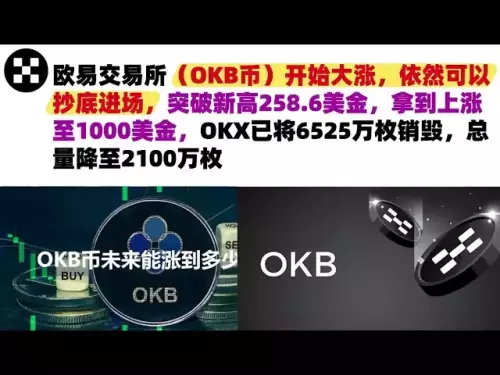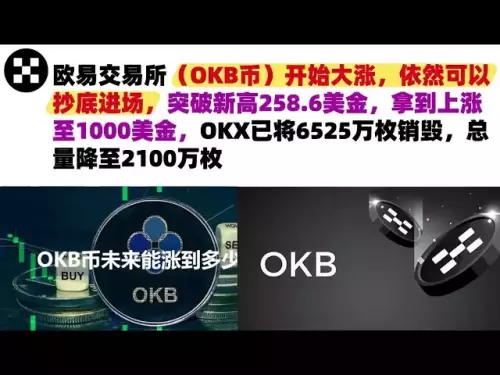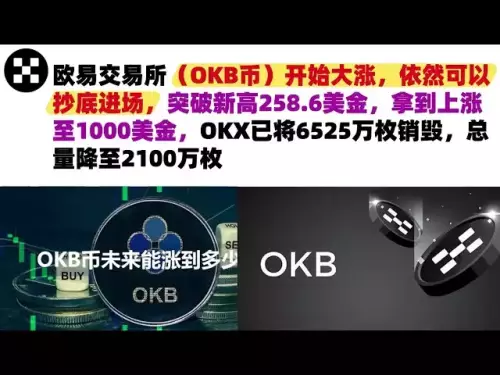-
 Bitcoin
Bitcoin $108900
0.46% -
 Ethereum
Ethereum $4373
0.96% -
 Tether USDt
Tether USDt $1.000
-0.01% -
 XRP
XRP $2.808
-1.19% -
 BNB
BNB $858.6
-0.17% -
 Solana
Solana $201.0
-3.00% -
 USDC
USDC $0.9998
-0.01% -
 Dogecoin
Dogecoin $0.2161
0.88% -
 TRON
TRON $0.3379
0.94% -
 Cardano
Cardano $0.8227
-0.84% -
 Chainlink
Chainlink $23.39
-0.59% -
 Hyperliquid
Hyperliquid $44.08
-1.97% -
 Ethena USDe
Ethena USDe $1.001
0.01% -
 Sui
Sui $3.305
-0.25% -
 Stellar
Stellar $0.3558
-1.34% -
 Bitcoin Cash
Bitcoin Cash $544.8
1.89% -
 Cronos
Cronos $0.3127
13.43% -
 Avalanche
Avalanche $23.88
1.03% -
 Hedera
Hedera $0.2253
-0.58% -
 UNUS SED LEO
UNUS SED LEO $9.500
0.68% -
 Litecoin
Litecoin $110.5
0.03% -
 Toncoin
Toncoin $3.132
1.74% -
 Shiba Inu
Shiba Inu $0.00001242
2.17% -
 Uniswap
Uniswap $9.754
1.80% -
 Polkadot
Polkadot $3.785
-0.02% -
 Dai
Dai $1.000
0.00% -
 Bitget Token
Bitget Token $4.539
0.24% -
 Aave
Aave $314.9
0.87% -
 Monero
Monero $257.9
-1.32% -
 Ethena
Ethena $0.6606
1.38%
How to use MACD with moving average? Which is more important, the moving average golden cross or the MACD golden cross?
Combining MACD with moving averages helps traders analyze trends and make informed decisions in crypto markets, with golden crosses signaling potential bullish trends.
May 26, 2025 at 01:56 am
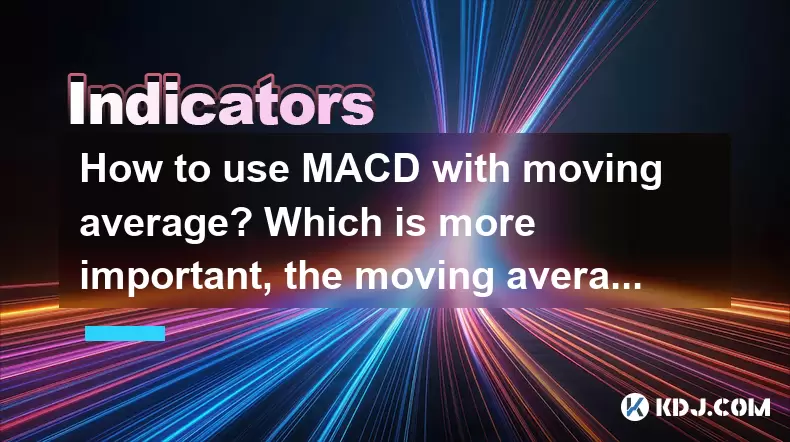
Using the MACD (Moving Average Convergence Divergence) with moving averages is a powerful approach for traders to analyze market trends and make informed decisions in the cryptocurrency market. This article will delve into how to effectively combine these two indicators and discuss the significance of their golden crosses.
Understanding MACD and Moving Averages
MACD is a momentum indicator that follows the trend of an asset by comparing two moving averages. It consists of the MACD line, the signal line, and the histogram. The MACD line is calculated by subtracting the 26-period exponential moving average (EMA) from the 12-period EMA. The signal line is a 9-period EMA of the MACD line, and the histogram represents the difference between the MACD line and the signal line.
Moving averages are used to smooth out price data to identify the direction of the trend. The most common types are the Simple Moving Average (SMA) and the Exponential Moving Average (EMA). For instance, a 50-day SMA calculates the average closing price of the last 50 days, while a 200-day SMA covers the last 200 days.
Combining MACD and Moving Averages
To effectively use MACD with moving averages in cryptocurrency trading, follow these steps:
- Select the Moving Averages: Choose the moving averages that best suit your trading strategy. Commonly used pairs are the 50-day and 200-day SMAs or EMAs.
- Plot the MACD: Add the MACD indicator to your chart. Ensure it includes the MACD line, signal line, and histogram.
- Analyze Trends: Use the moving averages to identify the overall trend. If the shorter-term moving average (e.g., 50-day) crosses above the longer-term moving average (e.g., 200-day), it indicates a potential bullish trend. Conversely, if it crosses below, it signals a bearish trend.
- Confirm with MACD: Use the MACD to confirm the trend identified by the moving averages. A bullish MACD crossover (MACD line crossing above the signal line) can confirm a bullish trend signaled by the moving averages. Similarly, a bearish MACD crossover (MACD line crossing below the signal line) can confirm a bearish trend.
The Golden Cross and Its Importance
A golden cross occurs when a shorter-term moving average crosses above a longer-term moving average, signaling a potential bullish trend. For example, a 50-day moving average crossing above a 200-day moving average is a common golden cross in cryptocurrency trading.
The MACD golden cross happens when the MACD line crosses above the signal line, which is also a bullish signal. Both types of golden crosses can be powerful indicators for traders, but their importance can vary depending on the context and timeframe.
Moving Average Golden Cross vs. MACD Golden Cross
Determining which golden cross is more important depends on various factors, including the trader's strategy, timeframe, and the specific cryptocurrency being analyzed.
- Moving Average Golden Cross: This is often considered more significant in longer-term trend analysis. It is widely recognized and can signal the start of a major bullish trend. Traders using this signal might look for a sustained upward movement in the price after the cross occurs.
- MACD Golden Cross: This is more sensitive to short-term price movements and can generate signals more frequently. It is useful for traders who engage in shorter-term trades and need to react quickly to changes in momentum. The MACD golden cross can provide early signals of trend reversals but may also result in more false positives.
Practical Application in Cryptocurrency Trading
To apply these indicators in your cryptocurrency trading, follow these steps:
- Choose Your Timeframe: Decide on the timeframe that aligns with your trading strategy. Shorter timeframes might be more suitable for day trading, while longer timeframes are better for swing or position trading.
- Set Up Your Chart: Add the selected moving averages and the MACD indicator to your chart. Ensure the moving averages are clearly visible and the MACD is plotted below the price chart.
- Monitor for Golden Crosses: Keep an eye out for both moving average and MACD golden crosses. A moving average golden cross might signal a longer-term trend, while a MACD golden cross could indicate a shorter-term opportunity.
- Confirm Signals: Use additional indicators or analysis techniques to confirm the signals provided by the golden crosses. For example, check the volume to see if it supports the trend indicated by the moving averages and MACD.
- Execute Trades: Based on the confirmed signals, execute your trades. If you see a moving average golden cross and a MACD golden cross aligning, it could be a strong buy signal. Conversely, if the signals do not align, it might be wise to wait for further confirmation.
Example of Using MACD and Moving Averages in Bitcoin Trading
Let's consider a practical example using Bitcoin (BTC). Suppose you are monitoring a daily chart with a 50-day SMA and a 200-day SMA, along with the MACD indicator.
- Identify the Moving Average Golden Cross: You notice that the 50-day SMA has crossed above the 200-day SMA, indicating a potential bullish trend for Bitcoin.
- Confirm with MACD: You then check the MACD indicator and see that the MACD line has crossed above the signal line, confirming the bullish trend suggested by the moving averages.
- Analyze Additional Factors: You review the trading volume and notice an increase in volume, which supports the bullish trend.
- Make a Decision: Based on the alignment of the moving average golden cross, the MACD golden cross, and the increased volume, you decide to enter a long position on Bitcoin.
Frequently Asked Questions
Q: Can MACD and moving averages be used for all cryptocurrencies?A: Yes, MACD and moving averages can be applied to any cryptocurrency. However, the effectiveness may vary depending on the liquidity and volatility of the specific cryptocurrency.
Q: How often should I check for golden crosses?A: The frequency depends on your trading strategy. For day traders, checking multiple times a day might be necessary, while swing traders might check daily or weekly.
Q: Are there any other indicators that can be used in conjunction with MACD and moving averages?A: Yes, other indicators such as the Relative Strength Index (RSI), Bollinger Bands, and the Stochastic Oscillator can provide additional insights and help confirm signals from MACD and moving averages.
Q: Can these indicators be used in automated trading systems?A: Absolutely, MACD and moving averages can be programmed into automated trading systems. However, it's important to backtest the system thoroughly to ensure the signals are reliable and profitable.
Disclaimer:info@kdj.com
The information provided is not trading advice. kdj.com does not assume any responsibility for any investments made based on the information provided in this article. Cryptocurrencies are highly volatile and it is highly recommended that you invest with caution after thorough research!
If you believe that the content used on this website infringes your copyright, please contact us immediately (info@kdj.com) and we will delete it promptly.
- Elon Musk, Dogecoin, and the Treasury Firm: A New Chapter?
- 2025-08-30 23:05:15
- Ethereum, Stocks, and NFTs: Navigating the Tipping Point in 2025
- 2025-08-30 22:45:29
- Bitcoin Price Under Pressure: Support Levels and Analyst Forecasts
- 2025-08-30 22:50:12
- Bitcoin, Trump & Trading: Decoding the Crypto Buzz
- 2025-08-30 21:25:13
- PENDLE Price: Buy Signal or Bad Move? A NYC Trader's Take
- 2025-08-30 21:25:13
- Avocado Coin Hack: Is Your Avocado Ripe Enough?
- 2025-08-30 21:30:13
Related knowledge

The EMA indicator is in a bearish pattern, but the MACD has formed a bottoming divergence. How should I choose?
Aug 30,2025 at 02:19pm
Bearish EMA vs. Bullish MACD Divergence: Understanding the Conflict1. The Exponential Moving Average (EMA) is a trend-following indicator that gives m...

The RSI indicator has become blunt and cannot break through the previous high. Is this a signal that the rally is over?
Aug 30,2025 at 08:01pm
Understanding RSI Behavior in Extended Bull Runs1. The Relative Strength Index (RSI) is a momentum oscillator that measures the speed and change of pr...

The MACD histogram has turned from green to red, but the fast and slow lines are still below the water level. How can I interpret this?
Aug 30,2025 at 07:13am
Understanding the MACD Histogram Shift1. The MACD histogram turning from green to red indicates a weakening of downward momentum in the price trend. T...
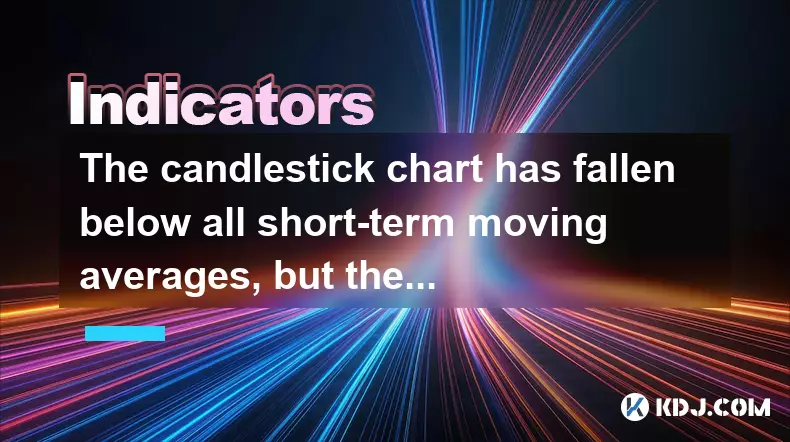
The candlestick chart has fallen below all short-term moving averages, but the long-term moving average remains upward. What's the market outlook?
Aug 30,2025 at 06:19pm
Understanding the Current Market Structure1. The price action has recently dropped beneath key short-term moving averages such as the 9-day, 20-day, a...
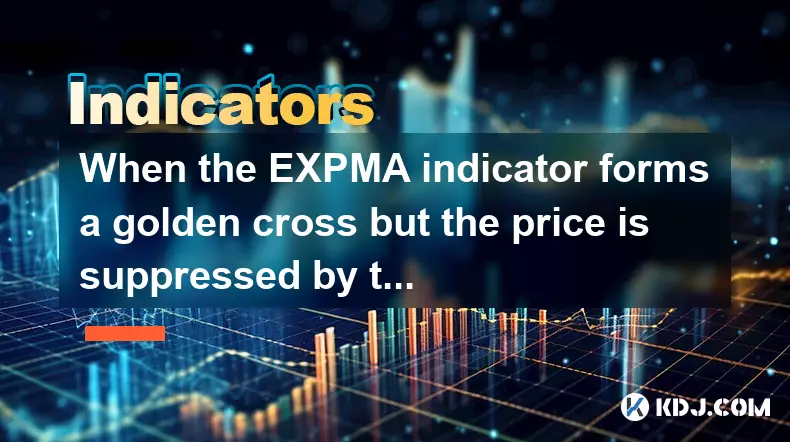
When the EXPMA indicator forms a golden cross but the price is suppressed by the upper moving average, how should I interpret it?
Aug 30,2025 at 07:18pm
Understanding the EXPMA Golden Cross in Constrained Price Action1. The EXPMA (Exponential Moving Average) golden cross occurs when a shorter-term EXPM...
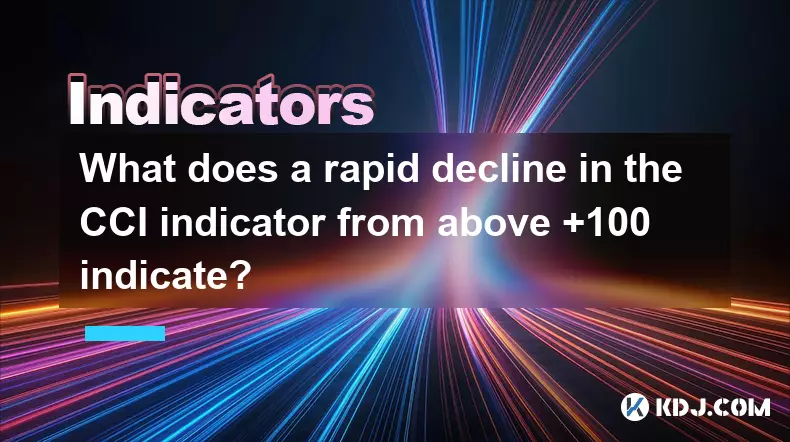
What does a rapid decline in the CCI indicator from above +100 indicate?
Aug 30,2025 at 05:17am
Rapid Decline in CCI from Above +100: Key Implications1. The Commodity Channel Index (CCI) is a momentum-based oscillator widely used in cryptocurrenc...

The EMA indicator is in a bearish pattern, but the MACD has formed a bottoming divergence. How should I choose?
Aug 30,2025 at 02:19pm
Bearish EMA vs. Bullish MACD Divergence: Understanding the Conflict1. The Exponential Moving Average (EMA) is a trend-following indicator that gives m...

The RSI indicator has become blunt and cannot break through the previous high. Is this a signal that the rally is over?
Aug 30,2025 at 08:01pm
Understanding RSI Behavior in Extended Bull Runs1. The Relative Strength Index (RSI) is a momentum oscillator that measures the speed and change of pr...

The MACD histogram has turned from green to red, but the fast and slow lines are still below the water level. How can I interpret this?
Aug 30,2025 at 07:13am
Understanding the MACD Histogram Shift1. The MACD histogram turning from green to red indicates a weakening of downward momentum in the price trend. T...

The candlestick chart has fallen below all short-term moving averages, but the long-term moving average remains upward. What's the market outlook?
Aug 30,2025 at 06:19pm
Understanding the Current Market Structure1. The price action has recently dropped beneath key short-term moving averages such as the 9-day, 20-day, a...

When the EXPMA indicator forms a golden cross but the price is suppressed by the upper moving average, how should I interpret it?
Aug 30,2025 at 07:18pm
Understanding the EXPMA Golden Cross in Constrained Price Action1. The EXPMA (Exponential Moving Average) golden cross occurs when a shorter-term EXPM...

What does a rapid decline in the CCI indicator from above +100 indicate?
Aug 30,2025 at 05:17am
Rapid Decline in CCI from Above +100: Key Implications1. The Commodity Channel Index (CCI) is a momentum-based oscillator widely used in cryptocurrenc...
See all articles























